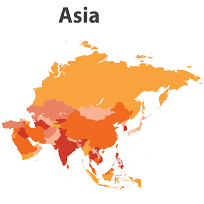Fidelity Asian Values plc (LON:FAS) performance is driven by stock selection, and that should never be overlooked. However, being in appealing markets gives favourable tailwinds, and, in this note, we highlight that Asia is now more appealing than ever, with i) growth accelerating into 2023 while developed economies slow, ii) lower inflation, iii) liberalisation of economies, iv) the full benefits of major new free trade agreements, and v) continued long-term positive demographic and urbanisation trends unaffected by short-term noise. FAV may further benefit from sentiment increasingly favouring its small-/mid-sized value focus, a trend that, arguably, has already started.
- Economic outlook: Growth in Asia in 2023 is expected to accelerate to more than double that of developed economies. As the latter slow, Asia is accelerating. Asia is not facing the same inflationary expectations, nor, as a consequence, the same pressures to raise interest rates. New trade agreements will also help growth.
- Market trends: Market sentiment has increasingly favoured FAV’s investment focus, with a move away from large-cap names, and an increasingly positive view on China. There remains a huge valuation gap between small-cap value and growth, which remains anomalous with underlying business performance.
- Valuation: Fidelity Asian Values is trading at a 9% discount to NAV – only a little better than its peers in the AIC Asia Pacific Smaller Companies Index (average discount 11%) and the broader Asia Pacific sector (average 9%), even though its one-year performance has been ca.11% better than the latter. Most assets are listed, making the NAV “real”.
- Risks: Geopolitical and economic tensions may affect investments, and also sentiment. If growth/momentum stocks are in favour (as they have been for much of the period since 2016), FAV faces a relative headwind, which it has usually, but not always, overcome. Volatility of returns is likely to be high.
- Investment summary: Fidelity Asian Values has delivered superior long-term returns by being in attractive growth markets and adding incremental value using structured, in-depth analysis to identify mis-priced investments. Its “value” investments have actually delivered higher earnings growth than the average Asian “growth” company, as well as being lower-rated and providing a higher return on equity. FAV is actively managed, and divergence from the benchmark performance, often for sustained periods, is to be expected.
Or you can listen to Analyst Mark Thomas discuss his report.






































